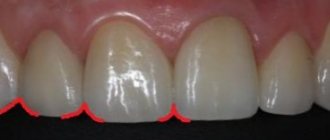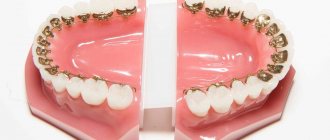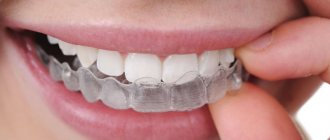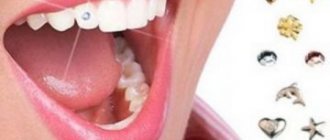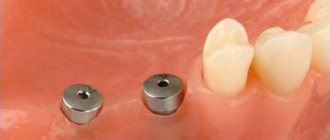A gummy smile is a physiological feature in which the upper gum is excessively exposed. With a normal smile, 1-2 mm of gum is visible; if more, then such a smile is called gingival or “gummy smile”. Such exposure of the mucous membrane is not considered a pathology, does not in any way affect diction, chewing function, or affects the health of the teeth.
However, studies claim that excessive mucosal exposure leads to decreased self-esteem and psychological changes in 25% of cases.
[1].
Causes of gummy smiles in children and adults
In adults, a gummy smile is quite rare, since this problem in most cases appears in childhood. There are several known main reasons for the appearance of this problem: improper development of the facial skeleton, a short upper lip that cannot cover the gum, or, on the contrary, an overly large gum that covers the upper row of teeth more than necessary. At the same time, a strongly pronounced gummy smile, as a rule, is a consequence of malocclusion, or anomalies in the development of the maxillofacial skeleton.
Causes
The gums are excessively exposed, mainly due to the structural features of the upper jaw ( maxilla
). Its excessive development leads to the fact that even a normal upper lip appears short and is unable to fully cover the mucous membrane.
Another reason is excessive elevation of the upper lip. If the orbicularis oris muscle is too strong (in medicine they use the term “overactive”), the lip rises higher than usual. In this case, the teeth and gums may be of normal size; the lip just lifts up too high, violating the proportions.
A short lip also leads to compromised smile aesthetics. The reason is a shortened frenulum, which lifts the lip upward.
A common cause of a gingival smile is gum overgrowth. Hyperplasia ( fibromatosis
) tissues leads to the fact that most of the tooth crown is covered, and even a slight smile exposes a significant part of the gum. Tissue proliferation can occur in diabetes mellitus and some blood diseases.
Bruxism, pathological abrasion of teeth, caries and trauma lead to the fact that the height of the crowns decreases and the gums are exposed. The same effect is observed with incomplete teething.
Some malocclusions, especially those with the upper incisors moving forward, also contribute to gum exposure.
Reconstructive surgery in the treatment of gummy smiles
In situations where a gummy smile appears as a result of abnormal development of the facial skeleton, the only effective solution to the problem is surgery. For these purposes, osteotomy (correction of the upper jaw) and ostectomy (operation performed to correct the lower jaw) are used.
In the vast majority of cases, such surgical interventions are carried out in the presence of serious anomalies in the development of the bite, but can also be performed in the normal position of the jaws, for example, to correct a gummy smile.
How to fix a gummy smile
Aesthetic dentistry uses surgical, orthodontic, orthopedic, cosmetic and even speech therapy correction methods. The degree of patient involvement depends on the method. In surgical cases, it is minimal, the effect is lasting, the patient is only required to follow the usual recommendations. Installing braces requires more discipline and involvement, and speech therapy exercises depend almost entirely on the patient’s responsibility and constant monitoring of articulation.
Surgical intervention
- Gum plastic surgery
for a gummy smile (gingivoplasty) is the most common correction method.
It is considered a simple operation and does not require going to the hospital. Takes a maximum of 2 hours, often less.
A dental surgeon performs an operation to remove excess tissue (gingivectomy) and shape the contour of the gums. The mucous membrane is lifted to make a larger area of the crown part of the tooth visible, and excess tissue is removed. Surgery to correct a gummy smile is minimally invasive and is done using a laser beam. It immediately seals the vessels, preventing bleeding. There are no stitches, so the recovery period takes little time. In addition, the laser destroys pathogenic flora; there are practically no complications after such operations.
The only thing worth remembering is that if you remove too much tissue, it will lead to the opposite aesthetic effect - long teeth. A special technology helps to avoid this result: “digital smile design.” Thanks to it, the result of the intervention can be seen even before the operation and it is possible to determine exactly how much tissue needs to be removed.
- Frenum cutting (frenuloplasty)
Another simple operation that improves not only the aesthetics of a smile, but also diction. The fact is that the lips are actively involved in articulation. A short lip cannot do this 100%, which affects the pronunciation of individual sounds and makes speech unclear and blurred. Additionally, people with a short frenulum tend to breathe through their mouths. This dries out the mucous membrane, creating conditions for colds and inflammatory processes in the nasopharynx. Frenuloplasty eliminates these problems by promoting clear articulation, correct breathing patterns, and at the same time making the smile more attractive. Typically, this procedure is performed in childhood, but some adults also experience a shortened frenulum.
- Suturing the orbicularis oris muscle
A minor surgical intervention reduces the tone of the muscle, and it stops lifting the lip too much. You can get rid of a gummy smile in less than an hour.
Orthodontic treatment
If you have problems with your bite, braces or aligners can help correct the position of your jaws. Some malocclusions cause the upper teeth to move out of the jaw, and the gums attached to them also move downward. Treatment with braces or mouthguards brings the teeth back, and with them the gums.
With severe pathology of the maxilla, orthognathic surgery is necessary. It is performed by a gnathologist or maxillofacial surgeon under general anesthesia. Some bone is removed to recreate symmetry between the upper and lower jaw. As a result, the height of the upper jaw decreases, the mucous membrane is not exposed excessively.
Orthopedic intervention
To visually lengthen teeth in case of pathological wear, for example, an orthodontist installs veneers or crowns. Veneers build up teeth by no more than 1-2 mm; if you need to build up more, artificial crowns are used.
Why is it better to do gingivoplasty “in your sleep”?
If the patient is very afraid and worried about the upcoming operation, we suggest performing it under sedation. This is an immersion into a state of light sleep with the help of safe sleeping pills under the supervision of our experienced anesthesiologist.
Sleep therapy provides:
- Maximum comfort A person does not feel pain or experience emotional stress. Awakening is, as usual, quick and easy.
- High-quality treatment The doctor is 100% focused on the operation, eliminating the possibility of inaccurate actions due to random movements of the patient.
- Risk prevention The patient is not worried, the blood pressure is normal, the risk of bleeding, and therefore the formation of edema and hematomas, is lower.
- Improved healing There is no release of stress hormone, which reduces the immunological status and slows down the regeneration processes.
Immunogenicity
Immunological complications during botulinum therapy are reduced to acute allergic reactions to human serum albumin. This phenomenon is possible when too high doses of the toxin are administered, which leads to the formation of IgH antibodies, the number of which increases in direct proportion to the volume of the administered BTA drug. The result of this reaction of the body is inactivation of the toxin. However, in aesthetic medicine, BTA preparations are usually used in very small doses, so the issue of immunogenicity is not a cause for concern.
What determines the cost of the operation?
The cost of gingivoplasty depends on the chosen method and the extent of surgical intervention.
Any, even the most advanced situation on the gums can be corrected and made better and more beautiful. But in some situations, previously performed procedures complicate the process of rehabilitation with old scars.
All types of gingival margin reconstruction directly depend on the gum biotype. The thicker the gingival contour, the cheaper and simpler the treatment. If the gums are of the ultra-thin biotype, any surgical treatment will be a challenge for the patient and the doctor.
Contraindications for surgery
Gum grafting is considered a minor surgical procedure, however, it has a number of contraindications. In particular, gingivoplasty is not performed if the patient:
- blood diseases, especially bleeding disorders;
- uncompensated diabetes mellitus;
- immune diseases in which such operations are prohibited;
- acute respiratory, inflammatory, infectious, etc. disease (temporary contraindication).
Also, before surgery, as a rule, it is recommended to carry out sanitation of the oral cavity, if necessary, to clean the gum pockets and get rid of tartar. This is necessary so that there are no pockets of infection left in the mouth, which can cause postoperative complications.
Tissue augmentation – during recession and implantation
Gum grafting with root exposure (recession)
solves not only aesthetic, but also medical issues, protecting this part of the tooth from increased sensitivity, caries formation and other problems. One of the common causes of recession is periodontitis and gingivitis. A similar disorder also occurs with periodontal disease; if the gum tissue is too thin; due to improper oral hygiene and a number of other reasons.
Build-up may also be required when installing an implant - when a tooth is removed, the volume of bone and gum tissue decreases over time. Accordingly, if it becomes insufficient for implantation, the tissue is built up. Sometimes it is necessary to work only on the gingival contour - so that the implant looks as aesthetically pleasing and natural as possible.
To cover exposed areas, so-called patchwork plastic surgery is often used. The doctor cuts the tissue in the treated area and replaces/extends the resulting flaps using flaps taken from the palate, cheek, and other areas of the periodontium. Then stitches are applied.
Features of the procedure and recovery
Gingivoplasty is performed with local anesthesia
. Depending on the complexity and scope of the tasks, the procedure takes from half an hour to several hours - it includes anesthesia, disinfection, direct work on the periodontium, cleaning of dental/bacterial plaque (if necessary), suturing, etc.
Healing time
also depend on the specifics of the intervention - usually from one to several weeks. The swelling subsides within 2-7 days. While the gums are being restored, the teeth may become a little loose, and increased sensitivity may also occur, but these phenomena will pass as the tissue heals. In general, during the rehabilitation period, patients should adhere to the following recommendations:
- carefully monitor oral hygiene (rinse your mouth after eating, use special solutions), but do not brush or paste the area where the operation was performed;
- Avoid foods that may irritate tissue. Excessively hard, hot, cold, spicy, sour foods, etc. are excluded;
- avoid physical activity, excessive shaking and anything that prolongs the healing period;
- use disinfecting solutions according to the schedule prescribed by the doctor;
- wear a special mouthguard.
Your doctor will give you detailed recommendations specific to your case.

